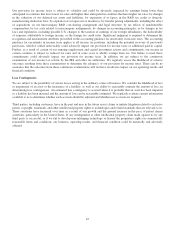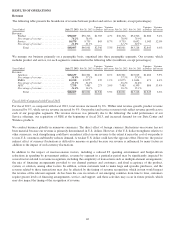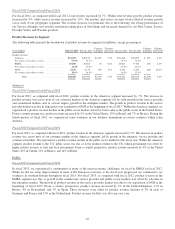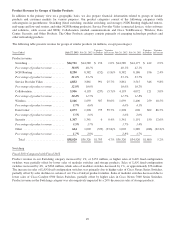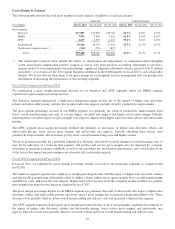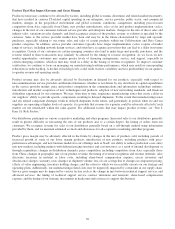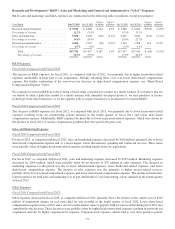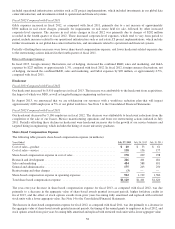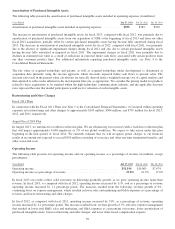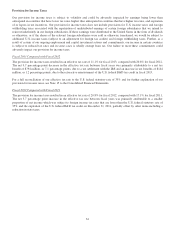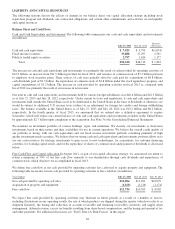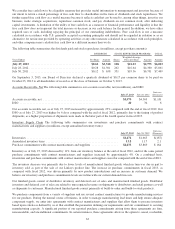Cisco 2013 Annual Report Download - page 62
Download and view the complete annual report
Please find page 62 of the 2013 Cisco annual report below. You can navigate through the pages in the report by either clicking on the pages listed below, or by using the keyword search tool below to find specific information within the annual report.
Fiscal 2012 Compared with Fiscal 2011
The following table summarizes the key factors that contributed to the change in product gross margin percentage from fiscal
2011 to fiscal 2012:
Product
Gross Margin
Percentage (1)
Fiscal 2011 ................................................ 60.5%
Sales discounts, rebates, and product pricing ...................... (2.4)%
Mix of products sold ......................................... (0.9)%
Productivity ................................................ 2.1%
Amortization of purchased intangible assets ...................... 0.3%
Restructuring and other charges ................................ 0.5%
Fiscal 2012 ................................................ 60.1%
(1) Beginning in fiscal 2013, we refined our methodology for presenting the items in the preceding table,
and accordingly certain reclassifications have been made to fiscal 2012 amounts to conform to the
presentation made for the fiscal 2013 amounts.
In fiscal 2012, product gross margin decreased by 0.4 percentage points compared with fiscal 2011. The decrease was primarily
due to the impact of higher sales discounts, rebates, and unfavorable product pricing, which were driven by normal market factors
and by the geographic mix of product revenue. These factors impacted most of our customer markets and all of our geographic
segments. Additionally, our product gross margin for fiscal 2012 was negatively impacted by the shift in the mix of products sold,
primarily as a result of revenue increases in our relatively lower margin Cisco Unified Computing System products and increased
revenue in other lower margin products. In fiscal 2012, we experienced a positive mix impact from the absence of the lower
margin consumer related products due to our exit from the Flip Video camera product line in fiscal 2011. The negative impacts to
product gross margin were partially offset by lower restructuring charges, the absence of significant impairment charges related to
purchased intangible assets, lower amortization expense in fiscal 2012 and productivity improvements. The productivity
improvements were in part due to increased benefits from our value engineering efforts, particularly in certain of our Switching
products; favorable component pricing; and continued operational efficiency in manufacturing operations.
Service Gross Margin
Fiscal 2013 Compared with Fiscal 2012
Our service gross margin percentage increased slightly by 0.1 percentage points for fiscal 2013, as compared with fiscal 2012.
Although we experienced higher sales volume from growth in both advanced services and in technical support services, the
resulting benefit to gross margin was offset by increased cost impacts such as headcount-related costs, partner delivery costs,
and unfavorable mix. The mix impacts were due to our lower gross margin advanced services business contributing a higher
proportion of service revenue for fiscal 2013, as compared with fiscal 2012.
Our service gross margin normally experiences some fluctuations due to various factors such as the timing of contract
initiations in our renewals, our strategic investments in headcount, and the resources we deploy to support the overall service
business. Other factors include the mix of service offerings, as the gross margin from our advanced services is typically lower
than the gross margin from technical support services.
Fiscal 2012 Compared with Fiscal 2011
Our service gross margin percentage increased by 0.5 percentage points for fiscal 2012, as compared with fiscal 2011. The
increase was primarily due to higher sales volume for both technical support services and advanced services. The benefit to
gross margin of increased volume was partially offset by increased headcount-related and partner delivery costs, and
unfavorable mix. The mix impacts were due to our lower gross margin advanced services revenue contributing a higher
proportion of service revenue for fiscal 2012, as compared with the prior year. Lower share-based compensation expense in
fiscal 2012 as compared with fiscal 2011 also added to the increase in service gross margin.
For fiscal 2012, as compared with fiscal 2011, gross margin from technical support services was flat as the benefits from a 10%
increase in revenue combined with lower supply chain costs were offset by higher headcount-related costs. For fiscal 2012, as
compared with fiscal 2011, gross margin in advanced services increased primarily due to a 20% increase in revenue in fiscal
2012. Partially offsetting the volume benefit were higher delivery team costs which were, in part headcount related, and higher
partner delivery costs. Our revenue from advanced services may increase to a higher proportion of total service revenue due to our
continued focus on providing comprehensive support to our customers’ networking devices, applications, and infrastructures.
54



